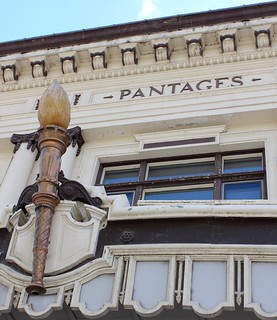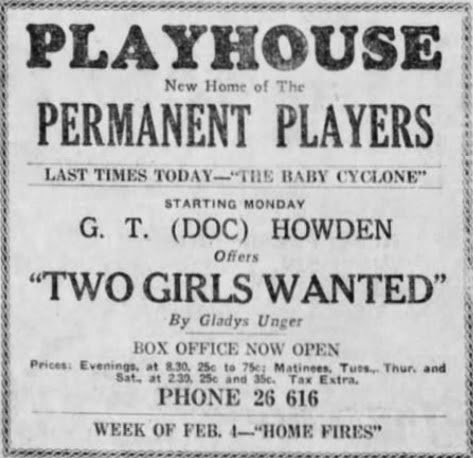This is part two of a four part history of the Pantages Playhouse Theatre in Winnipeg.
Aside from searching out new tenants or show companies, he also needed a new name.
October 6, 1923, Winnipeg Free Press
In August, it was announced that the theatre would be rechristened that Playhouse and that he has signed a lease agreement with a New York-based company called Broadway Players Ltd.. They would send a stock company troupe of actors from New York who would put on a combination of Broadway dramas and locally-written shows.
September 23, 1923, Winnipeg Tribune
Starting October 8, 1923 the theatre was back in action with "The Acquittal". The pace demanded a new show every week or two, so new actors were constantly revolving in and out. Keeping their promise of incorporating local shows into the lineup, a November offering was "Tthe Land of Promise - A Play of Manitoba's Wheat Fields".
Some of the performers brought in for shows went on to be stars. Maurice Franklin went from stage to radio as an actor and announcer. Spencer Tracy had a small role in the January 1924 production of Right is Right and, according to a Winnipeg Free Press article, (likely provided by the company itself as it appeared almost word for word in the Tribune !), of January 15: "...received generous applause for his presentation of the typical cop."
February 14, 1924, Winnipeg Tribune
There were rumours of financial difficulties within the theatre company. In January they dropped ticket prices to give "better value", then had two-for-one sales on Mondays and Tuesdays. Their final performance was in February 1925.
Over the next years, theatre manager John Fiddes rented out the theatre, mostly to local groups. The Playhouse hosted boxing matches, political speakers, dance recitals, St. Patrick's Day concerts, a production by the Winnipeg Blind Players.
October 8, 1927, Winnipeg Tribune
Bronaugh's company put on about a dozen shows per season, with July and August off, in 1926, 1927 and part of 1928. Each featured her in the starring role.
July 8, 1927, Winnipeg Tribune
In July 1927 the Bronaugh Players Ltd. purchased the theatre. It was made up of investors from the eastern U.S. and represented by Samuel Hale, a Boston accountant and sometimes actor, who was the group's treasurer. In December 1927, it was announced that the ownership group had changed. It was now made up mostly of local investors, with the exception of Hale, the chief investor. he moved to Winnipeg to become the Playhouse's general manager.
At the end of January 1928 Bronaugh was gone from the city and a new group, the Manitoba Players, was formed by Hale. it featured a new leading lady, Edna Preston, and leading man Karl Huebl. The group put on a number of plays and musicals until the summer break. In June, Hale announced that he had leased the theatre to "Major Graham", a Regina theatre owner, for the following season. He brought through a number of plays by the Gordinier Players, which appears to have been a U.S.-based travelling company.
January 26, 1929, Winnipeg Tribune
After what appeared to have been a successful season, the Players announced in May that they would be back in September with a full line-up of shows. They did not return.
August 31, 1929, Winnipeg Tribune
When September came, a new local stock company began their run. It featured local actors Hazel Brown and Charles P. Wright, (who would go on to be an executive at CBC in Winnipeg, Ottawa and head office.) They lasted only until November, when another stock company, Famous Players, tried to make a go of it. They only put on a few shows and were gone by April 1930.
There would be no new theatre season for the Playhouse. The Depression cut out high-cost entertainment from people's budgets and many travelling companies from the east had curtailed or completely cut their tours.
September 28, 1930, Winnipeg Tribune
The Playhouse was back to local fare. Dance recitals, concerts, the odd local play. many were to raise money for charities.
Whenever the Playhouse was in between theatre groups, boxing was a popular draw. Most were local matches, sponsored by the police association of football club. In 1930 local boxing promoter Jack Cancilla put together a number of larger bouts, including one between K.O. White of Chicago and the U.K.'s Ted Moore in September.
November 7, 1930, Winnipeg Tribune
After a spate of boxing, the Playhouse it became known as a concert venue for a number of local groups. The Men's Musical Club did a series of concerts starting in October 1930, as did the the Winnipeg Symphony Orchestra staring in November. Soon came the Winnipeg String Chorus, a Folks Arts Festival and a Manitoba Music Festival
For 1930-32 there was a Celebrity Concert Series which brought in a number of well-known classical performers. They included the likes of Roland Hayes, Lawrence Tibbett, Albert Spalding, Vladimir Horowitz, Sigrid Onegin, Richard Crooks and Paul Robeson.
In 1933 theatre made a return as the Winnipeg Little Theatre moved in and their guest director, Jacob Ben-Ami, also did a number of Jewish theatre productions.
In fact, by the 1932 - 33 season the theatre had cobbled together enough concerts, recitals, and plays from traveling theatre troupes to keep busy pretty much every week. It was short lived, though.When the Winnipeg Auditorium opened in 1932, most of the concert events switched to the new venue.
In June 1933 Pantages Theatre quietly closed.
May 10, 1935, Winnipeg Free Press
The owner, it is unclear who it was at that point, tried to sell it in 1935 and when there were no takers, the city got it at the annual tax sales. A sign of how dire the outlook was for the venue: the back taxes owing amounted to just $4,400.
It became part of a $6 million, and growing, portfolio of properties that Winnipeggers had walked away from during the Depression. (In 1936 the city also became the owner of the Walker Theatre under the same circumstances.)
The Playhouse Theatre, built in 1914 for $180,000 with another $70,000 or so in furnishings, was now assessed at $125,000 and the land $26,000. By 1937, after sitting vacant for the better part of four years, the assessed value had further shrunk to shrunk to $96,000.
If the theatre was going to survive, it was up to the city to find willing renters or a buyer.
Related Links
Pantages Playhouse Theatre homepage
Pantages Theatre Winnipeg Architecture Foundation
180 Market Avenue Historical Buildings Committee
History of Live Theatre in Winnipeg Manitoba HistoryJanuary 18, 1926 program University of Iowa Library
©2014 Christian Cassidy
This is part two of a four part history of the Pantages Playhouse Theatre in Winnipeg.
























No comments:
Post a Comment